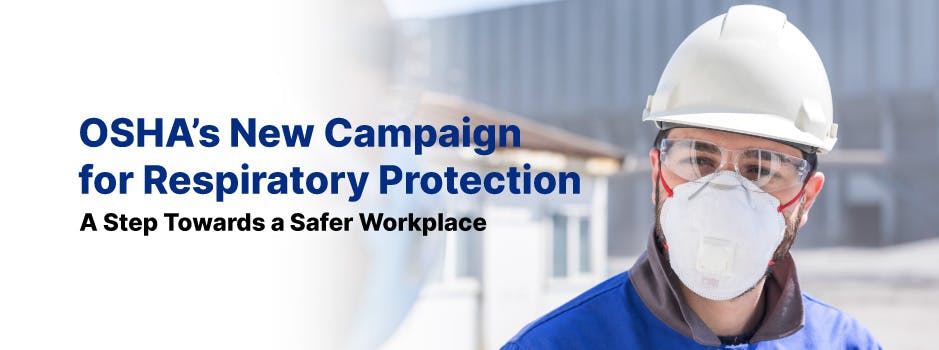On March 21, 2023, the Occupational Safety and Health Administration (OSHA) launched a new national campaign focused on respiratory protection for workers. This initiative aims to increase awareness and promote the use of appropriate protective equipment to prevent work-related respiratory illnesses. The goal is to reduce the number of workplace-related respiratory diseases and enhance worker safety. In this article, we will delve into the details of this campaign, discuss its significance, and evaluate its potential impact on workplace safety.
Background
Respiratory hazards are a serious concern in many industries, including construction, manufacturing, healthcare, and agriculture. Workers in these fields are often exposed to dust, fumes, gases, and other harmful substances that can lead to various respiratory problems. To ensure workers' safety and prevent the occurrence of respiratory diseases, OSHA has always emphasized the importance of proper respiratory protection.
According to OSHA's data, thousands of workers suffer from work-related respiratory illnesses each year. These diseases can have severe consequences, including long-term disability, reduced quality of life, and premature death. In light of these alarming statistics, OSHA has decided to launch a national campaign to raise awareness about the importance of respiratory protection and provide guidance to both employers and employees.
OSHA's Respiratory Protection Campaign
The primary objectives of OSHA's new campaign are to educate employers and employees about the importance of respiratory protection and encourage compliance with OSHA's respiratory protection standards. The campaign focuses on the following key areas:
-
Awareness: OSHA aims to increase awareness about the potential hazards associated with various workplace environments and the importance of using proper respiratory protection. The campaign will leverage various communication channels, including social media, print materials, and workshops, to reach a broad audience.
-
Training and education: The campaign will provide resources and training materials to help employers and employees understand the requirements of OSHA's respiratory protection standard (29 CFR 1910.134). This includes information on how to properly select, use, and maintain respiratory protection equipment.
-
Compliance assistance: OSHA will offer support to employers to help them comply with the respiratory protection standard. This includes providing technical assistance, conducting on-site consultations, and offering guidance on developing effective respiratory protection programs.
-
Enforcement: OSHA will continue to enforce its respiratory protection standard by conducting inspections and taking appropriate action against employers who fail to comply with the requirements.
The Importance of Respiratory Protection
Respiratory protection is vital for workers exposed to hazardous substances in their workplace. Some of the reasons why respiratory protection is essential include:
-
Preventing respiratory diseases: Proper use of respiratory protection can significantly reduce the risk of developing work-related respiratory illnesses, such as asthma, silicosis, and lung cancer.
-
Compliance with regulations: OSHA's respiratory protection standard requires employers to establish and maintain a respiratory protection program. This includes providing appropriate respiratory protection equipment, training employees on its proper use, and ensuring that the equipment is well-maintained.
-
Enhancing productivity: Workers who are protected from respiratory hazards can focus on their tasks without the fear of developing long-term health issues. This can lead to increased productivity and a more positive work environment.
-
Cost savings: Investing in respiratory protection can save employers money in the long run by reducing the costs associated with workers' compensation claims, lost workdays, and decreased productivity due to respiratory illnesses.
Tips for Implementing an Effective Respiratory Protection Program
To help employers create an effective respiratory protection program, OSHA offers the following tips:
- Perform a hazard assessment: The first step in developing a respiratory protection program is to identify and evaluate the respiratory hazards in the workplace. This includes considering the types of substances workers may be exposed to, the duration and frequency of exposure, and the potential health effects of such exposure.
-
Select appropriate respiratory protection: Based on the hazard assessment, employers should choose suitable respiratory protection equipment for their workers. This may include disposable filtering facepiece respirators, elastomeric respirators, or powered air-purifying respirators (PAPRs), depending on the specific hazards and workplace conditions.
-
Provide proper training: Employers should ensure that employees receive comprehensive training on the proper use, limitations, and maintenance of respiratory protection equipment. This includes how to don and doff the equipment, perform a user seal check, and identify signs of malfunction or damage.
-
Establish a fit-testing program: OSHA requires that workers who use tight-fitting respirators undergo fit testing to ensure that the selected respirator provides an adequate seal to the face. Employers should develop a fit-testing program that meets OSHA's requirements and ensures that workers receive fit tests at least annually.
-
Maintain and inspect equipment: Regular maintenance and inspection of respiratory protection equipment are crucial to ensure its continued effectiveness. Employers should establish a schedule for inspecting, cleaning, repairing, and replacing equipment as needed.
-
Evaluate program effectiveness: Employers should periodically evaluate the effectiveness of their respiratory protection program to identify any areas for improvement. This may include reviewing records of worker exposures, conducting employee surveys, and analyzing trends in work-related respiratory illnesses.
Conclusion
OSHA's national campaign for respiratory protection is a significant step towards improving worker safety and reducing the incidence of work-related respiratory illnesses. By raising awareness, providing training and education, offering compliance assistance, and enforcing regulations, OSHA aims to create a safer workplace environment for millions of workers across the United States.
Employers play a crucial role in implementing effective respiratory protection programs and ensuring the safety of their employees. By following OSHA's guidelines and investing in appropriate respiratory protection equipment and training, employers can not only comply with regulations but also foster a healthier and more productive work environment.
As the campaign progresses, it will be essential to monitor its impact on workplace safety and respiratory health outcomes. By working together, OSHA, employers, and employees can make significant strides in reducing the risk of respiratory illnesses and creating safer work environments for all.

